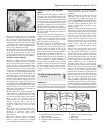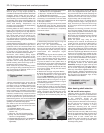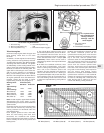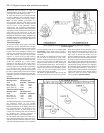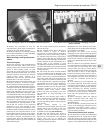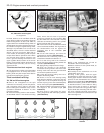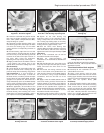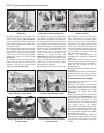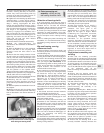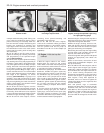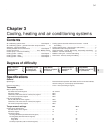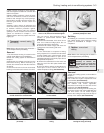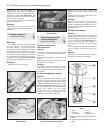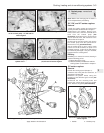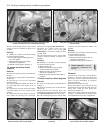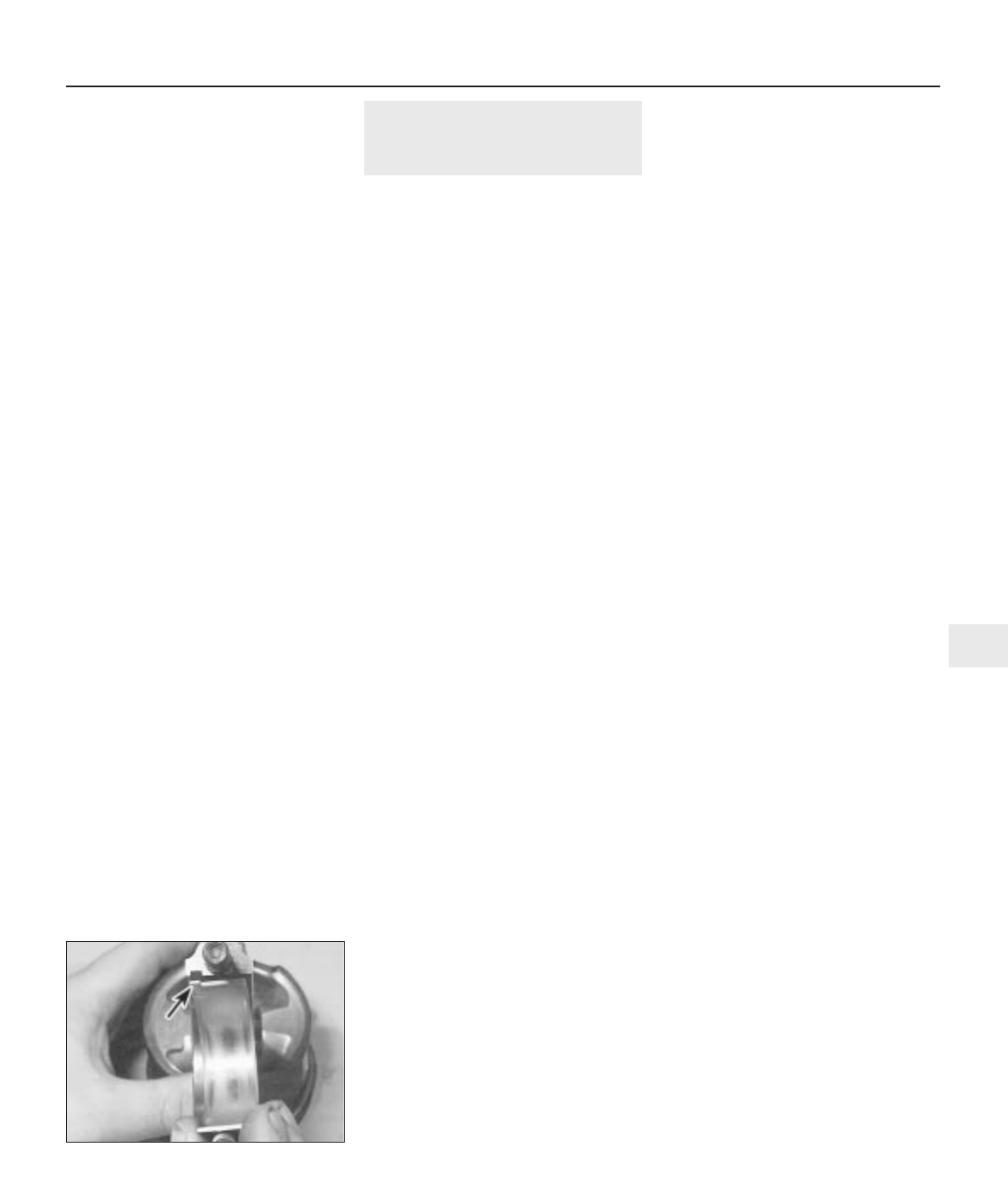
87 Fit the main bearing caps to their correct
locations, ensuring that they are fitted the
correct way round (the bearing shell lug
recesses in the block and caps must be on
the same side). Insert the bolts loosely.
88 Tighten the main bearing cap bolts to the
specified Stage 1 torque wrench setting.
Once all the bolts have been tightened to the
Stage 1 setting, angle-tighten the bolts
through the specified Stage 2 angle, using a
socket and extension bar. It is recommended
that an angle-measuring gauge is used during
this stage of the tightening, to ensure
accuracy. If a gauge is not available, use a
dab of white paint to make alignment marks
between the bolt head and casting prior to
tightening; the marks can then be used to
check that the bolt has been rotated
sufficiently during tightening.
89 Check that the crankshaft rotates freely.
90 Refit the piston/connecting rod
assemblies to the crankshaft as described in
Section 14.
91 Refit the Woodruff key to the crankshaft
groove, and slide on the oil pump drive
sprocket. Locate the drive chain on the
sprocket.
92 Ensure that the mating surfaces of front
oil seal housing and cylinder block are clean
and dry. Note the correct fitted depth of the
front oil seal then, using a large flat-bladed
screwdriver, lever the seal out of the housing.
93 Apply a smear of suitable sealant to the oil
seal housing mating surface, and make sure
that the locating dowels are in position. Slide
the housing over the end of the crankshaft,
and into position on the cylinder block.
Tighten the housing retaining bolts securely.
94 Repeat the operations in paragraphs 92
and 93, and fit the rear oil seal housing.
95 Fit a new front and rear crankshaft oil seal
as described in Part C of this Chapter.
96 Ensuring that the chain is correctly
located on the drive sprocket, refit the oil
pump and sump as described in Part C of this
Chapter.
97 Refit the flywheel as described in Part C of
this Chapter.
98 Where removed, refit the cylinder head
and install the crankshaft sprocket and timing
belt as described in the relevant Sections of
Part C.
14 Piston/connecting rod
assembly - refitting and big-
end bearing clearance check
4
Selection of bearing shells
1 On most engines, there are two sizes of
big-end bearing shell produced by Peugeot; a
standard size for use with the standard
crankshaft, and an oversize for use once the
crankshaft journals have been reground.
2 Consult your Peugeot dealer for the latest
information on parts availability. To be safe,
always quote the diameter of the crankshaft
big-end crankpins when ordering bearing
shells.
3 Prior to refitting the piston/connecting rod
assemblies, it is recommended that the big-
end bearing running clearance is checked as
follows.
Big-end bearing running
clearance check
4 Clean the backs of the bearing shells, and
the bearing locations in both the connecting
rod and bearing cap.
5 Press the bearing shells into their locations,
ensuring that the tab on each shell engages in
the notch in the connecting rod and cap. Take
care not to touch any shell’s bearing surface
with your fingers (see illustration). If the
original bearing shells are being used for the
check, ensure that they are refitted in their
original locations. The clearance can be
checked in either of two ways.
6 One method is to refit the big-end bearing
cap to the connecting rod, ensuring that they
are fitted the correct way around (see
paragraph 21), with the bearing shells in
place. With the cap retaining nuts correctly
tightened, use an internal micrometer or
vernier caliper to measure the internal
diameter of each assembled pair of bearing
shells. If the diameter of each corresponding
crankshaft journal is measured and then
subtracted from the bearing internal diameter,
the result will be the big-end bearing running
clearance.
7 The second, and more accurate method is
to use Plastigage (see Section 13).
8 Ensure that the bearing shells are correctly
fitted. Place a strand of Plastigage on each
(cleaned) crankpin journal.
9 Refit the (clean) piston/connecting rod
assemblies to the crankshaft, and refit the
big-end bearing caps, using the marks made
or noted on removal to ensure that they are
fitted the correct way around.
10 Tighten the bearing cap nuts as described
below in paragraph 22 or 23 (as applicable).
Take care not to disturb the Plastigage, nor
rotate the connecting rod during the
tightening sequence.
11 Dismantle the assemblies without rotating
the connecting rods. Use the scale printed on
the Plastigage envelope to obtain the big-end
bearing running clearance.
12 If the clearance is significantly different
from that expected, the bearing shells may be
the wrong size (or excessively worn, if the
original shells are being re-used). Make sure
that no dirt or oil was trapped between the
bearing shells and the caps or block when the
clearance was measured. If the Plastigage
was wider at one end than at the other, the
crankshaft journal may be tapered.
13 Note that Peugeot do not specify a
recommended big-end bearing running
clearance. The figure given in the
Specifications is a guide figure, which is
typical for this type of engine. Before
condemning the components concerned,
refer to your Peugeot dealer or engine
reconditioning specialist for further
information on the specified running
clearance. Their advice on the best course of
action to be taken can then also be obtained.
14 On completion, carefully scrape away all
traces of the Plastigage material from the
crankshaft and bearing shells. Use your
fingernail, or some other object which is
unlikely to score the bearing surfaces.
Final piston/connecting rod
refitting
15 Note that the following procedure
assumes that the cylinder liners (where fitted)
are in position in the cylinder block/crankcase
as described in Section 9, and that on XU and
TU series engines, the crankshaft and main
bearing ladder/caps are in place (see Section
13). On XV, XW and XY series engines, do not
fit the crankshaft until all the
piston/connecting rod assemblies have been
inserted.
16 Ensure that the bearing shells are
correctly fitted as described earlier. If new
shells are being fitted, ensure that all traces of
the protective grease are cleaned off using
paraffin. Wipe dry the shells and connecting
rods with a lint-free cloth.
17 Lubricate the cylinder bores, the pistons,
and piston rings, then lay out each
piston/connecting rod assembly in its
respective position.
18 Start with assembly No 1. Make sure that
the piston rings are still spaced as described
in Section 12, then clamp them in position
with a piston ring compressor.
19 Insert the piston/connecting rod assembly
into the top of cylinder/liner No 1. Ensure that
the arrow on the piston crown is pointing
towards the timing chain/belt end of the
engine. Using a block of wood or hammer
handle against the piston crown, tap the
assembly into the cylinder/liner until the
piston crown is flush with the top of the
cylinder/liner (see illustration).
20 On XV, XW and XY series engines, refit
the remaining three piston/connecting rod
assemblies in the same way. The crankshaft
should then be placed in position in the
crankcase as described in Section 13.
21 Ensure that the bearing shell is still
correctly installed. Liberally lubricate the
Engine removal and overhaul procedures 2D•23
2D
14.5 Ensure that the tab (arrowed) is
correctly located in the connecting rod
when fitting the bearing shells



